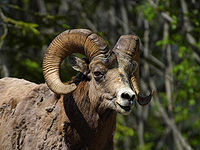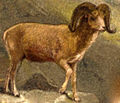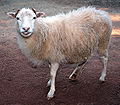- Ovis
-
- This article refers to the sheep genus. For the species commonly referred to simply as "sheep", see Domestic sheep.
Sheep 
Bighorn Sheep Scientific classification Kingdom: Animalia Phylum: Chordata Class: Mammalia Order: Artiodactyla Family: Bovidae Subfamily: Caprinae Genus: Ovis
Linnaeus, 1758Species See text.
Ovis is a genus of mammals, part of the goat-antelope subfamily of the ruminant family Bovidae.[1] Its five or more highly gregarious species are known as sheep. The domestic sheep is one member of the genus, and is thought to be descended from the wild mouflon of central and southwest Asia.
Contents
Terminology
Female sheep are called ewes, males are called rams (sometimes also called bucks or tups) and young sheep are called lambs. The adjective applying to sheep is ovine and the collective term for sheep is flock or mob. The term herd is also occasionally used in this sense. There is a large number of specialist terms relating to domestic sheep.
Characteristics
Sheep are usually stockier than most other bovines, and their horns are usually divergent and curled into a spiral. Sheep have scent glands on the face and feet. Communication through the scent glands is not well understood but is thought to be important for sexual signaling. Males can smell females that are fertile and ready to mate, and rams mark their territories by rubbing scent on to rocks. Like other ruminants, they have a four-chambered stomach which plays a vital role in digesting, regurgitating, and redigesting food. Domestic sheep are used for their wool, milk, and meat (which is called mutton or lamb).
Species
Five species and numerous subspecies of sheep are currently recognised, although some subspecies have also been considered full species. The following are the main ones:[1]

Ovis ammon Argali 
Ovis aries aries[2] Domestic sheep 
Ovis orientalis orientalis group Mouflon 
Ovis orientalis vignei group Urial 
Ovis canadensis Bighorn sheep 
Ovis dalli Dall Sheep Ovis nivicola Snow sheep Behaviour
Wild sheep are mostly found in hilly or mountainous habitats. They are fairly small compared to other ungulates; in most species adults weigh less than 100 kilograms (220 lb).[3] Their diet consists mainly of grasses, as well as other plants and lichens. Like other bovids, their digestive system enables them to digest and live on low-quality, rough plant materials. Sheep conserve water well and can live in fairly dry environments. The bodies of wild sheep (and some domestic breeds) are covered by a coat of thick hair to protect them from cold. This coat contains long, stiff hairs, called kemps, over a short woolly undercoat, which grows in autumn and is shed in spring.[4] It is this woolly undercoat which has been developed in many domestic sheep breeds into a fleece of long wool; this replaces the kemp hairs in these breeds. The fleece covers the body (in a few breeds also the face and legs) and is used for fibre.
Sheep are social animals and live in groups, called flocks. This helps them to avoid predators and also helps them stay warm in bad weather by huddling together. Flocks of sheep need to keep moving to find new grazing areas and more favourable climate as the seasons change. In each flock, there is a sheep, usually a mature ram, which the others follow as a leader.[4]
In wild sheep, both rams and ewes have horns, while in domestic sheep (depending upon breed) horns may be present in both rams and ewes, in rams only, or in neither. Rams' horns may be very large – those of a mature bighorn ram can weigh 14 kilograms (31 lb) – as much as the bones of the rest of its body put together. Rams use their horns to fight with each other for dominance and for the right to mate with females. In most cases, they do not injure each other because they hit each other head to head and their curved horns do not strike each other's bodies. They are also protected by having very thick skin and a double-layered skull.[5]
Wild sheep have very keen senses of sight and hearing. When detecting predators, wild sheep most often flee, usually uphill to higher ground. However, they can also fight back. The Dall sheep has been known to butt wolves off the face of cliffs.[5]
References
- ^ a b Grubb, Peter (16 November 2005). "Order Artiodactyla (pp. 637-722)". In Wilson, Don E., and Reeder, DeeAnn M., eds. Mammal Species of the World: A Taxonomic and Geographic Reference (3rd ed.). Baltimore: Johns Hopkins University Press, 2 vols. (2142 pp.). pp. 707-710. ISBN 978-0-8018-8221-0. OCLC 62265494. http://www.bucknell.edu/msw3/browse.asp?id=14200814.
- ^ ICZN (International Commission on Zoological Nomenclature) opinion 2027
- ^ Nowak, R. M. and J. L. Paradiso. 1983. Walker's Mammals of the World. Baltimore, Maryland: The Johns Hopkins University Press. ISBN 0801825253
- ^ a b Clutton-Brock, J. 1999. A Natural History of Domesticated Mammals. Cambridge, UK : Cambridge University Press ISBN 0521634954
- ^ a b Voelker, W. 1986. The Natural History of Living Mammals. Medford, New Jersey: Plexus Publishing, Inc. ISBN 0937548081
- Bulanskey, S. 1992. The Covenant of the Wild. New York: William Morrow and Company, Inc. ISBN 0688096107
- Parker, D. 2001. The Sheep Book. Athens, Ohio, USA : Ohio University Press ISBN 0804010323
See also
- Aries, the Ram (astrological sign)
- Barbary Sheep (Ammotragus lervia), another type of goat antelope, not closely related to Ovis sheep.
- Blue sheep or bharal (Pseodois), two species of goat antelopes, not closely related to Ovis sheep.
- Domestic sheep
- Glossary of sheep husbandry
- List of sheep breeds
- Sheep husbandry
External links
- Miller, S. 1998. "Sheep and Goats". United States Department of Agriculture, Foreign Agricultural Service
- Oklahoma State University (OSU). 2003 Breeds of Livestock: Sheep Retrieved January 13, 2007
- Huffman, B. 2006. The Ultimate Ungulate Page Website Retrieved January 13, 2007
Wikimedia Foundation. 2010.
